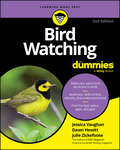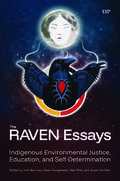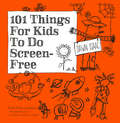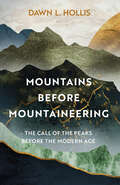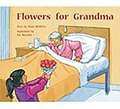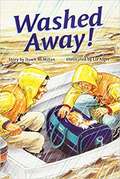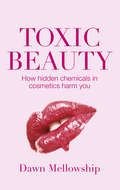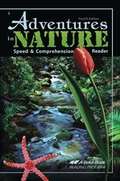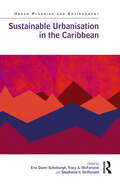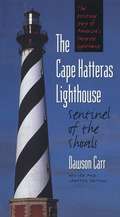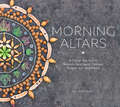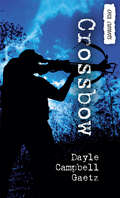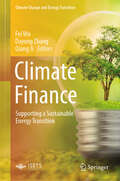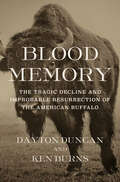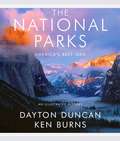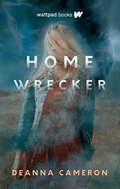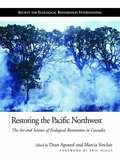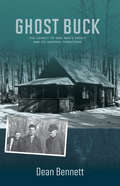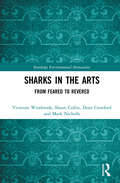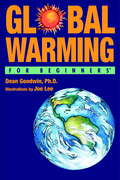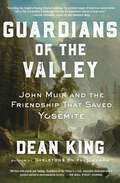- Table View
- List View
Bird Watching For Dummies
by Julie Zickefoose Jessica Vaughan Dawn HewittBirds are everywhere. Why not start really watching them?Sometimes, all it takes is a “spark bird” to open the door. A bird, seen well, so unexpectedly beautiful and interesting that it cracks you wide open. Bird Watching For Dummies is a spark book, teaching you all you need to know about this fun, affordable, and accessible hobby. It gently guides as you explore your local habitats, learn to recognize more and more species, and reap the many mental health benefits of connecting to the outdoors and all the wonders it holds. This book gets you started, teaching you how to identify birds by sight and sound, find birdwatching hotspots, and get the birds to come to your own backyard. You’ll learn about the latest gear, the best field guides and online apps that will jump-start your bird identification skills. Into photography? This book has your back, with tips on getting good photos for identification and aesthetic purposes. Find out how to join a local bird club, find a field trip or a group tour to rainforest, desert, seacoast, mountains or prairie. Every habitat has its own special birds, and when the birding bug bites, you’ll want to see them all. Get started with bird watching or take your hobby to the next level Improve your skills with tips for identifying birds by sight and sound Understand bird behavior and learn gardening tips that will bring the birds to you Choose field guides, binoculars, apps, and other tools of the trade Bird Watching For Dummies will teach beginners and novices how to start bird watching, sharpen their bird watching skills, and expand their knowledge.
The RAVEN Essays: Indigenous Environmental Justice, Education, and Self-Determination
by John Borrows Susan Smitten Max Ritts Dawn HoogeveenNamed after the Respecting Aboriginal Values and Environmental Needs (RAVEN) nonprofit organization, The RAVEN Essays is an anthology that celebrates a decade of prize-winning student essays. Since 2012, RAVEN has awarded an annual essay prize to honour students who champion the vital importance of Indigenous rights and self-determination, both in Canada and globally. The essays featured in this collection highlight exceptional student work while reflecting on the evolving relationship between Indigenous politics and academia. From issues like fishing rights and the Trans Mountain Pipeline to challenges of sexism and conservation policy, these essays capture a transformative period in Indigenous struggles, offering insights that resonate far beyond the Canadian settler state.The anthology also includes contributions from prominent scholars such as Glen Coulthard, Dara Culhane, Michael Fabris, Sarah Hunt, and Heather Dorries. Five complementary essays explore various aspects of structural change, institutional constraints, and broader commitments to Indigenous knowledge within university settings. Aimed at readers in Indigenous law, environmental studies, anthropology, and geography, The RAVEN Essays is a book created by students for students, and by academics for the academy. Together, the contributors reflect on the powerful formation and enactment of Indigenous law, environmental stewardship, place-based knowledge, pedagogy, and literacy – both within the academy and in the broader community, across land, water, and culture.
101 Things for Kids to do Screen-Free (101 things)
by Dawn Isaac'Packed with original ideas.' - the Telegraph on 101 Things for Kids To Do on a Rainy Day'A quarter of the price of a theme-park ticket and delivers significantly better value for money.' - the Independent on 101 Things for Kids To Do Outside From bestselling kids' activity author Dawn Isaac comes this exciting new volume full of creative, fun and occasionally silly ideas for games and activities. From creating a mini golf course to mastering hands-free eating, from squirt gun painting to microwave mug cakes, every single activity is fun, easy and 100 per cent screen free. With exciting makes including no-sew sock creatures and stress balls, and wacky games such as outdoor noughts and crosses and thumb wrestling tournaments, Dawn's engaging and entertaining ideas are sure to provide hours of fun.So put away your tablets and mobile phones, switch off the TV and leave the computer alone - it's time to get screen free.
Once Upon a Tree
by Dawn Jarocki Soren KisielThis fable of a little leaf looking for his purpose will delight children and their caretakers.The whirling, swirling adventures of an ordinary little leaf high on a tree, struggling to find its purpose. The leaf watches baby birds break out of their shells and grow until they learn to fly. Caterpillars wrap themselves in silk and emerge as magnificent butterflies. Warm sunny days get shorter and windy chilly nights grow longer. The little leaf is terribly worried that it should be transforming too. It no longer noticed anything other than the thoughts spinning in its head. The leaf held on to the tree with all its might, growing exhausted as increasingly cooler winds blew. Then one day, the leaf noticed it had become a beautiful crimson color. And it became aware that maybe, maybe it was time for the leaf to fly too. The leaf was very tired, so it just let go. As it danced and twirled to the ground in the amber sunlight, the leaf finally learns its own unique purpose.
Mountains before Mountaineering: The Call of the Peaks before the Modern Age
by Dawn L. HollisToday, mountains are spaces for adventure: treasured places for people to connect with nature, encounter the sublime and challenge themselves, whether it be skiing in the Italian Alps or scaling the heights of the Matterhorn in Switzerland. Some regard our love of mountains as relatively new, claiming that before modern mountaineers planted flags upon the peaks, the average European was more likely to revile and avoid a mountainous landscape than to admire it.Mountains Before Mountaineering tells a different narrative. It reveals the way mountains inspired curiosity and fascination and how they were enjoyed in sixteenth- and seventeenth-century Europe. It gives voice to the early modern travellers who climbed peaks and passes with fear and delight; to the ‘real mountaineers’ who lived and died upon the mountain slopes; and to the scientists who used mountains to try to understand the origins of the world.This book invites you on a journey through the mountains, long before Everest was ‘discovered’ as the highest mountain in the world or before the first recorded ascent of Mont Blanc. It is the story of how our love of the mountains has been a part of us from the very beginning.
SCIENCE: Order & Design
by Dawn McKenzieExplore the many wonderful levels of creation with this colorful and beautifully designed book! From taking a look at the things you might find in your backyard to the species that occupy the rainforest, your child will receive a greater understanding of the beautiful world that God has created. Other topics included are healthy living, the miraculous stages of a baby’s development, exploring the animals of the sea, the intricate designs of the plant life, and more! Section reviews are included to support the information that your child has learned in each lesson.
Flowers for Grandma: Individual Student Edition Yellow (levels 6-8) (Rigby Pm Stars)
by Dawn McMillanElla comes home and finds out that her Grandma is in hospital. Ella wants to take her red flowers from the garden.
Washed Away! (Rigby PM Plus Blue (Levels 9-11), Fountas & Pinnell Select Collections Grade 3 Level Q)
by Dawn McMillanThe emergency sirens are wailing, and the flood waters have reached the end of Nicholas's street. Nicholas and his dad are ready to evacuate to the rescue centre. But what about William? Dad says cats can swim, but Nicholas won't be happy until the rains are over and he can go back home to find William.
Toxic Beauty: The hidden chemicals in cosmetics and how they can harm us
by Dawn MellowshipEvery year we each absorb an estimated 2 kilograms of chemicals through beauty and cosmetic products. Chemicals found in lipsticks, skin lotions and hair dyes have been linked with tumours, cell mutation, allergies, reproductive complications, endocrine disruption and cancer. Isn't it time we all paid more attention to exactly what goes into the eye shadows, body washes and deodorants we love to use? This compelling and timely book tells you the key chemicals you should avoid, reveals just how natural 'organic' beauty products really are, and features a directory highlighting the health issues surrounding a wide range of products, from hair gel to sunscreens.
Adventures in Nature: Speed and Comprehensive Reader
by Marion Hedquist Michelle Johnson Dawn Mereness Phyllis RandBeginning in fourth grade, the reading program provides specific opportunities for students to develop comprehension skills. At this level, students are responsible for much more history and science material and outside reading. Their vocabulary work is increased, and they are expected to retain many more facts. Begin now to stress the importance of reading for information at the best possible speed. Because the reading program for the lower elementary grades stresses phonics and reading mastery, students are now ready to work on these other reading skills.
Understanding God’s World
by Dawn MerenessThe Author describes GOD's creation in his books, about Science, Insects, Plants, Birds, Water, Air, Weather, Sound and Hearing. Geology, Planet Earth, Oceanography, Wonders of the Sea and Astronomy.
Sustainable Urbanisation in the Caribbean (ISSN)
by Stephanie V. McDonald Dawn Schoburgh, Edited by ErisSustainable Urbanisation in the Caribbean critically examines the socio-geographic context of island states, prioritising the nuanced experiences of Caribbean island states and territories that are largely considered small island developing states (SIDS), against the backdrop of the UN Sustainable Development Goals (SDGs).Increases in urban density place enormous pressure on existing infrastructures and natural resources, exacerbating social inequalities and environmental risks. While the UN SDGs aim to mitigate these risks, the reality of implementing these goals in the context of SIDS is complex. Whereas Sustainable Urbanisation in the Caribbean does not claim to be a comprehensive assessment of policy responses to the SDGs, this edited volume seeks to generate problem-focused, policy-relevant, demand-driven research, thereby permitting the geographical contexts of island states to contribute to the development of proper causal theory about sustainable urbanisation.This book will be of interest to students of public policy, urban sustainability and climate change, as well as government policy analysts, development practitioners, urban planners and UN agencies working in SIDS.
The Cape Hatteras Lighthouse
by Dawson CarrSince 1871 the Cape Hatteras lighthouse has been a welcome sight for sailors entering the treacherous region off North Carolina's Outer Banks known as the Graveyard of the Atlantic. At 208 feet high, it is the tallest lighthouse in the country and one of the state's most famous landmarks. Through the years, it has withstood the ravages of both humans and nature, weathering numerous violent storms and two wars. But perhaps the gravest threat the structure faced in recent history was the erosion of several hundred yards of beach that once stood between it and the ocean. As powerful tides and rising sea levels increasingly endangered the lighthouse's future, North Carolinians debated fiercely over how best to save it, eventually deciding on a controversial plan to move the beacon inland to safety. First published by UNC Press in 1991, this book tells the story of the noble lighthouse from its earliest history to the present day. In this new edition, Dawson Carr details the recent relocation of the treasured landmark. For now, it seems, North Carolinians have succeeded in protecting their lighthouse, as it has protected them for over a century.
Morning Altars: A 7-step Practice To Nourish Your Spirit Through Nature, Art, And Ritual
by Day SchildkretReturn to the earth with beautiful photographs and inspirational text. “Morning altars” are colorful mandalas that combine nature, art, and meditation. Incorporating the natural world into the everyday encourages positive well- being, even with the simplest of the earth’s gifts, such as leaves, flowers, berries, feathers, and stones. These stunning pieces of art are a peaceful and creative avenue to express gratitude for nature, to practice mindfulness, and to add meaning to daily life. In this book, Day Schildkret guides readers through the creation of morning altars, a seven- step process that includes wondering and wandering, place meditation, clearing space, creating, gifting, walking away, and sharing his art with others. Since his first morning altar, Schildkret has built hundreds more. His work has been warmly received on social media and he teaches workshops on altar building, all with the intention of sharing the positivity and beauty they have brought to his life.
Crossbow (Orca Currents)
by Dayle Campbell GaetzFourteen-year-old Matt has only one goal in life: to become a hermit. He has no use for school, but he loves the solitude of the forest. When he hikes up to the cabin he built for himself, he discovers a mysterious stranger named Forrest has moved in. At first, Matt doesn't connect Forrest's appearance with the rash of local robberies. Forrest seems to be the perfect hermit, and he teaches Matt the skills he needs to achieve his goal, including how to hunt with a crossbow. But when Forrest tries to kill an endangered Roosevelt elk, Matt questions the ethics of his new friend. When Matt discovers a stolen rifle in his cabin, he finds himself trapped in a dangerous situation. This short novel is a high-interest, low-reading level book for middle-grade readers who are building reading skills, want a quick read or say they don’t like to read!
Climate Finance: Supporting a Sustainable Energy Transition (Climate Change and Energy Transition)
by Fei Wu Qiang Ji Dayong ZhangThis book focuses on the frontier issues in climate finance and aims to develop a general framework to understand the financial pathways towards a successful energy transition. It builds upon the general descriptions of the current status and future challenges towards carbon neutral targets, and then bring forward a combination of theoretical and empirical analysis on the critical issues related to climate finance. Estimated by the International Energy Agency (IEA), trillions dollars of investment in energy sector are needed to achieve net-zero emission scenario. It provides a huge opportunity for our economies, meanwhile creates considerable challenges to the existing system. Both financing and investment in such an unprecedented scale cannot possibly be satisfied by the current financial architecture, which creates demands for restructuring in the financial sector, developing innovative financial instruments, building mechanisms to attract private investment, and establishing human resources to facilitate climate financing and investment. This area is essentially interdisciplinary, which requires a fundamental reconsideration of standard approaches. Aiming to satisfy the broad interests from both academia and policymakers, the contents of this book range from general discussions on critical issues to advanced statistical analyses on key topics. Authors hope to bring forward a general picture about climate finance and facilitate the demands for both academic research and policymaking. It should also provide a good guidance for graduate students interested in this subject. The main contents of this book are based on solid research outcomes but with clear policy relevance. The book combines finance theory and practices in both financial markets and energy sectors to reflect the complex nature of financing for energy transition. While the materials can provide useful knowledge to policymakers, the book can also inspire new research ideas in the relevant area.
Blood Memory: The Tragic Decline and Improbable Resurrection of the American Buffalo
by Ken Burns Dayton DuncanThe epic story of the buffalo in America, from prehistoric times to today—a moving and beautifully illustrated work of natural historyThe American buffalo—our nation&’s official mammal—is an improbable, shaggy beast that has found itself at the center of many of our most mythic and sometimes heartbreaking tales. The largest land animals in the Western Hemisphere, they are survivors of a mass extinction that erased ancient species that were even larger. For nearly 10,000 years, they evolved alongside Native people who weaved them into every aspect of daily life; relied on them for food, clothing, and shelter; and revered them as equals.Newcomers to the continent found the buffalo fascinating at first, but in time they came to consider them a hindrance to a young nation&’s expansion. And in the space of only a decade, they were slaughtered by the millions for their hides, with their carcasses left to rot on the prairies. Then, teetering on the brink of disappearing from the face of the earth, they would be rescued by a motley collection of Americans, each of them driven by different—and sometimes competing—impulses. This is the rich and complicated story of a young republic's heedless rush to conquer a continent, but also of the dawn of the conservation era—a story of America at its very best and worst.
The National Parks: An Illustrated History
by Ken Burns Dayton DuncanThe companion volume to the new Ken Burns film: a magnificently illustrated history of the American National Park System. In a rich, deeply informative narrative, Dayton Duncan and Ken Burns examine how each new park was brought into the system.
Homewrecker
by DeAnna CameronThey say it is quietest in the eye of a storm . . . they lied.Bronwyn’s mother is late. Again. Sitting on the edge of the sidewalk, waiting, Bronwyn figures she’s flaked out again. She’s always flaking out. Stomping home ready for a fight, Bronwyn is met by a cataclysmic tornado heading directly toward their run-down trailer. Bronwyn barely escapes with her life. Her mother isn’t as lucky.Enter Senator Soliday, a.k.a. Bronwyn’s estranged father, who shows up at the hospital and takes her home with him, to a family she’s never been a part of, to people who have proved again and again they don’t want her. Confused, resentful, absolutely raging, Bronwyn enters a world she’s never been privy to, while reeling from the news that her mother wasn’t killed by the tornado but murdered.Torn between two identities: the daughter of a single drug addict and the middle child of a well-respected senator, Bronwyn is forced to navigate through this new, unfamiliar life alone and with a gut feeling she can’t shake.Her mother’s killer isn’t unfamiliar.
Restoring the Pacific Northwest: The Art and Science of Ecological Restoration in Cascadia (Science Practice Ecological Restoration)
by Eric Higgs Marcia Sinclair Dean ApostolThe Pacific Northwest is a global ecological "hotspot" because of its relatively healthy native ecosystems, a high degree of biodiversity, and the number and scope of restoration initiatives that have been undertaken there. Restoring the Pacific Northwest gathers and presents the best examples of state-of-the-art restoration techniques and projects. It is an encyclopedic overview that will be an invaluable reference not just for restorationists and students working in the Pacific Northwest, but for practitioners across North America and around the world.
Ghost Buck: The Legacy Of One Man's Family And Its Hunting Traditions
by Dean BennettIn Ghost Buck, outdoorsman Dean Bennett takes readers along to the place where he feels most connected to nature and his family--Camp Sheepskin. Guided by his family's camp register, photos, and letters ranging from the 1800s to the present, Bennett reflects on his annual visits to his Western Maine camp since his boyhood. Through intimate narrative, he recalls hunting triumphs and defeats, including the elusive Ghost Buck that haunts the camp's surrounding forest. This multi-generational tale combines memoir, history, and politics as it illustrates the environmental and cultural changes that have altered hunting and the rural culture of the Maine woods. Ghost Buck is not a book about how to hunt, but rather a story of how a tradition like hunting in Maine can forge unshakeable family bonds
Sharks in the Arts: From Feared to Revered (Routledge Environmental Humanities)
by Dean Crawford Mark Nicholls Vivienne Westbrook Shaun CollinThis book is the most thorough exploration to date of the many ways in which a wild creature has been absorbed, reimagined and represented across the ages in all of the major art forms. The authors consider not only how the identity of sharks in the natural environment became incorporated into a cultural environment but also how sharks came to be considered the most feared creatures in the open oceans as a consequence of this incorporation. Yet sharks are especially important in helping to maintain a balance that is essential to the health of the oceans. The book begins with a treatment of the three sharks at the top of global shark-attack files from scientific, economic and environmental perspectives. Subsequent chapters engage with cultural representations of sharks in poetry, drama, art, novels, screenplay adaptations and films. Through an exploration of the ways in which sharks have been represented in human culture through the centuries, this book alerts the global community to the importance of sharks as a common cultural heritage. It aims to change perceptions of sharks so that they can become more revered than feared. The authors of this book argue that an increased understanding of sharks should lead to the development of better strategies for shark and human interactions. This book will be of great interest to researchers and students of the Environmental Humanities, Cultural History and the Arts. It is also excellent supplementary reading for courses in Zoology and Marine Science.
Global Warming for Beginners
by Dean GoodwinThe science is in: Global warming is for real. But what does it all really mean, and what can or should we do about it? This clear, fluid narrative by a leading scientist and educator takes a scrupulously balanced approach in explaining for the reader the history of global climate monitoring and change, and the who’s, how’s, what’s, when’s, where’s and why’s of the interaction between human activity and recent trends in the Earth’s climate. Global Warming For Beginners is organized into five compelling sections: Global Warming, An Introduction The Cause The Consequences The Solutions What Steps Can I Take? Working from the premise that no one can do everything but everyone can do something, Goodwin challenges readers with experiments they can conduct to gain a better understanding of the science underlying the problems facing our planet, and concludes with a list of fifty easy actions people can choose from to start doing their part in the effort to slow or stop global warming. As with all For Beginners titles, this volume is illustrated throughout with entertaining drawings that help readers understand and retain the information in Goodwin’s lively and comprehensive text.
Lucky's Gold Mine (Lucky Ladd Ser. #3)
by Dean HughesStaying temporarily in snow-covered Montana, eleven-year-old Lucky gets to know a tough, angry tomboy and finds himself her only salvation when her life is in danger. Most people don't think that Lucky is really all that lucky. If there's anything slippery nearby, he'll find it and trip. His toes must have obstacle-seeking devices on them to find things to stumble over. Since his father is in a business that checks out disasters, they travel from place to place in their motor home. Lucky makes new friends at church and school, only to say good-bye to them a few weeks later. What kind of good luck is that? Ron Ladd, Lucky's father, insists that no one is luckier. Lucky manages to get through accidents that would wipe out other kids. And though he's small for his size and gets picked on, he always seems to avoid getting beat up. His luck just gets luckier when they travel to West Yellowstone in winter, where it doesn't hurt to fall down. Snow, you see, is soft. Then, on the very first day, Lucky hears about a lost gold mine from a kid named Bob. He gets to go snowmobiling and search for treasure. Eventually, they think they find their gold mine--and something else entirely different. There are over 55 more books by Dean Hughes in Bookshare's library. Three of them are about Lucky. You'll find a funny series about Nutty Nutsell and there are series about baseball, soccer, football, and soldiers. There are also some stand alone novels about boys.
Guardians of the Valley: John Muir and the Friendship that Saved Yosemite
by Dean KingThe dramatic and uplifting story of legendary outdoorsman and conservationist John Muir&’s journey to become the man who saved Yosemite—from the author of the bestselling Skeletons on the Zahara: A True Story of Survival.In June of 1889 in San Francisco, John Muir—iconic environmentalist, writer, and philosopher—meets face-to-face for the first time with his longtime editor Robert Underwood Johnson, an elegant and influential figure at The Century magazine. Before long, the pair, opposites in many ways, decide to venture to Yosemite Valley, the magnificent site where twenty years earlier, Muir experienced a personal and spiritual awakening that would set the course of the rest of his life. Upon their arrival the men are confronted with a shocking vision, as predatory mining, tourism, and logging industries have plundered and defaced &“the grandest of all the special temples of Nature.&” While Muir is consumed by grief, Johnson, a champion of society&’s most pressing debates via the pages of the nation&’s most prestigious magazine, decides that he and Muir must fight back. The pact they form marks a watershed moment, leading to the creation of Yosemite National Park, and launching an environmental battle that captivates the nation and ushers in the beginning of the American environmental movement. Beautifully rendered, deeply researched, and inspiring, Guardians of the Valley is a moving story of friendship, the written word, and the transformative power of nature. It is also a timely and powerful &“origin story&” as the toweringly complex environmental challenges we face today become increasingly urgent.
